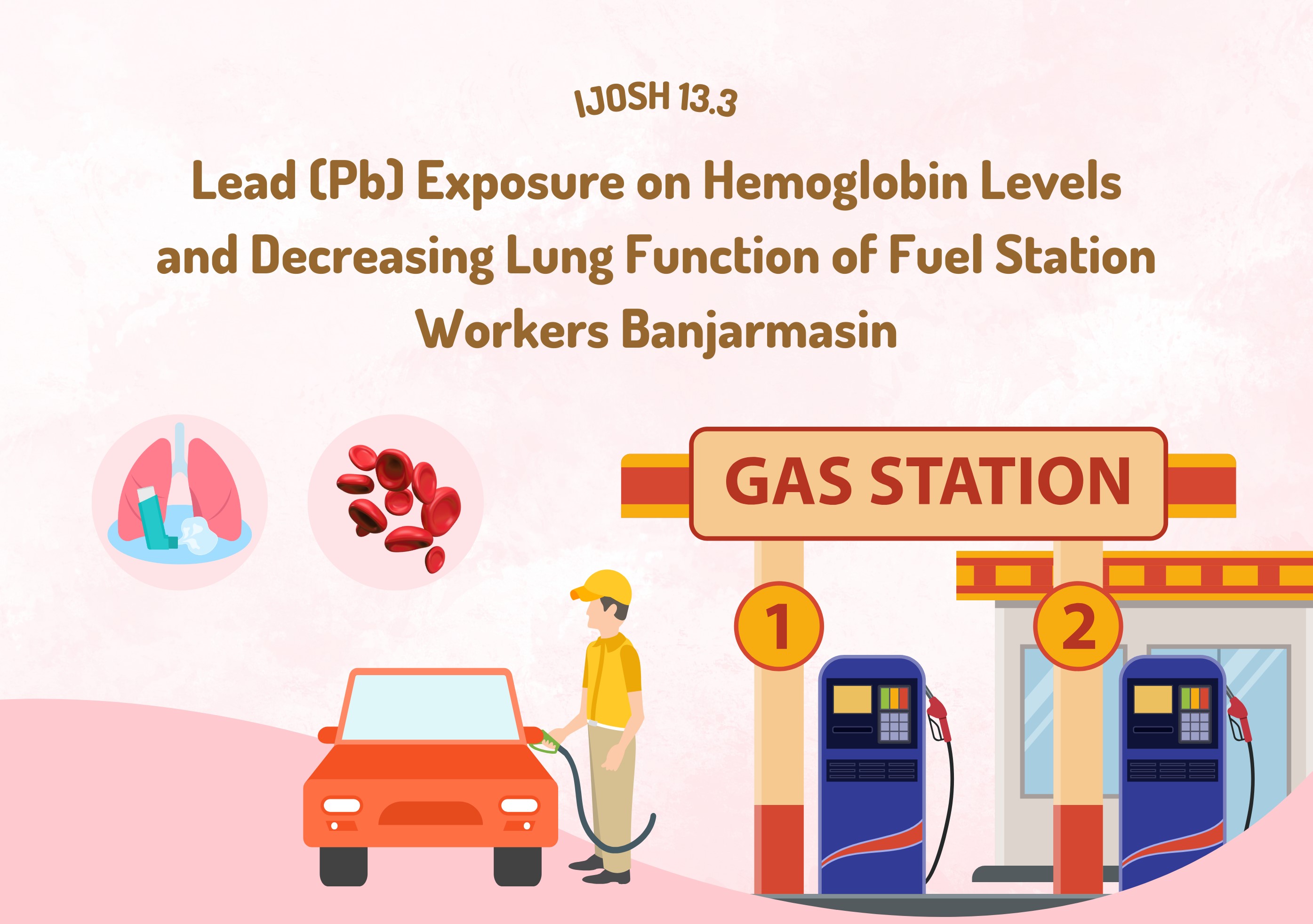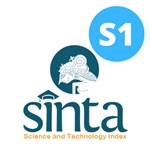Lead (Pb) Exposure on Hemoglobin Levels and Decreasing Lung Function of Fuel Station Workers Banjarmasin

Downloads
Introdution:Exposure to airborne pollutants such as lead (Pb) can cause health problems. Fuel stations are one of
the places with a high risk of Pb exposure sourced from fuel or motor vehicle exhaust emissions. This research aims to
know the effect of Pb exposure on hemoglobin levels and lung function in fuel station workers. Methods: This study
was observational, analytical, and cross-sectional on 40 fuel station workers in South Banjarmasin District. Urinary Pb
measurement was carried out by spectrophotometry, then the relationship to peripheral blood hemoglobin (Hb) levels and
lung function was analyzed based on FEV1 (%), FVC (%), and FEV1/FVC ratio with a simple linear regression test. The
data met the classical assumptions of normality, heteroscedasticity, and with no autocorrelation. If abnormal distribution
was found, data transformation was carried out. Results: Study obtained urinary Pb levels below the normal threshold of
0.0356±0.0074 ppm. Respectively, urinary Pb levels did not have a significant effect on Hb levels (mean±SD:14.39±1.41,
adjusted R2:6.2%, p=0.067), FEV1 (94.15±6.93, 5.8%, p=0.074) and FVC (89.68±6.24, 0.5%, p=0.380). However, urinary
Pb significantly correlated with decreasing the FEV1/FVC ratio (90.87±3.36, 10%, p=0.026) with the equation y=96.550
159.454x even without any obstruction value. Conclusion: This study showed that urinary Pb levels were normal. An
increase in urinary Pb levels has a significant effect on decreasing the FEV1/FVC ratio. Prevention to reduce the health
impacts of Pb needs to be taken. More research on at-risk populations with longer years of service needs to be done
Alkufi, A.A., Oleiwi, M.H. and Abojassim, A.A. (2024) 'Comparison of Heavy Metals in Urine Samples of Smoker and Non-smoker Persons', Biological Trace Element Research, pp. 1–7. doi:10.1007/S12011-024-04097-5/METRICS
Awadallah, M.F.M., et al. (2020) 'Pulmonary Misfortune Ensuing to Petroleum Related Employments', Open Journal of Respiratory Diseases, 10(02), pp. 21–31. doi:10.4236/ojrd.2020.102003
Balali-Mood, M., et al. (2021) 'Toxic Mechanisms of Five Heavy Metals: Mercury, Lead, Chromium, Cadmium, and Arsenic', Frontiers in Pharmacology, 12, pp. 1–19. doi:10.3389/FPHAR.2021.643972
Bawaskar, H.S. and Bawaskar, P.H. (2020) 'Blood Lead Level among Fuel Station Workers, Ganesh Idol Painters, Persons with Routine Daily Application Lead Containing Black Pigment to Eyes and Garage Workers', Journal of Family Medicine and Primary Care, 9(2), pp. 1376–1379. doi:10.4103/jfmpc.jfmpc
Van der Burgh, A.C., et al. (2021) 'Determinants of the Evolution of Kidney Function With Age', Kidney International Reports, 6(12), pp. 3054–3063. doi:10.1016/J.EKIR.2021.10.006
Centers for Disease Control and Prevention (2023) Biomonitoring Summary | CDC, Centers for Disease Control and Prevention. Available at: https://www.cdc.gov/biomonitoring/Lead_BiomonitoringSummary.html (Accessed: 6 October 2023).
Chen, C., et al. (2023) 'Associations between Environmental Heavy Metals Exposure and Preserved Ratio Impaired Spirometry in the U.S. Adults', Environmental Science and Pollution Research International, 30(49), p. 108274. doi:10.1007/S11356-023-29688-Y
Curtis, J.L. (2023) 'Understanding COPD Etiology, Pathophysiology, and Definition', Respiratory Care, 68(7), pp. 859–870. doi:10.4187/RESPCARE.10873
Dinas Komunikasi dan Informatika Kalimantan Selatan (2022) Informasi Umum RDTR Wilayah Pengembangan (WP) Kawasan Industri Terpadu Kota Banjarmasin.
Elisa, D.S., Pet al. (2024) 'Description of Blood Lead Levels with Uric Acid Concentration Regarding Smoking and Period Time Habits of Exposure Batik Industry Workers', Indonesian Journal of Global Health Research, 6(5), pp. 2301–2308.
Hollingsworth, A.,et al. (2020) 'Lead Exposure Reduces Academic Performance: Intensity, Duration, and Nutrition Matter', Political Methods: Experiments & Experimental Design eJournal.
Huwaida, T.A., Rahardjo, M. and Setiani, O. (2016) ‘Faktor-Faktor Risiko Yang Berhubungan Pada Pekerja di Perusahaan Rokok Wido di Kabupaten Kudus’, Jurnal Kesehatan Masyarakat, 4(3), pp. 911–920.
Inomoto, A., et al. (2019) 'Frequency of Exposure to Secondhand Smoke Outside the Home Is Associated with a Lower FEV1/FVC in Male Workers Regardless of Smoking Status', Journal of UOEH, 41(1), pp. 15–24. doi:10.7888/JUOEH.41.15
International Labor Organization (2021) Report World Health Organisation, Joint Estimates of the Work-related Burden of Disease and Injury, 2000–2016.
Kalahasthi, R., et al. (2022) 'Association between Occupational Lead Exposure and Immunotoxicity Markers: A Systematic Review and Meta-Analysis', Toxicology, 465, p. 153047. doi:10.1016/J.TOX.2021.153047
Leal M.F.C., et al. (2023) 'The Influence of the Biometals Cu, Fe, and Zn and the Toxic Metals Cd and Pb on Human Health and Disease', Trace Elements and Electrolytes, 40(1), pp. 1–22. doi:10.5414/TE500038
Lee, H.J. and Lee, H.Y. (2024) 'Characterization of Lung Function Impairment and Pathological Changes Induced by Chronic Lead and Cadmium Inhalation: Insights from a Mouse Model Study', Ecotoxicology and Environmental Safety, 283, p. 116776. doi:10.1016/J.ECOENV.2024.116776
Liu, Z. H., et al. (2020) 'Oxidative Stress Caused by Lead (Pb) Induces Iron Deficiency in Drosophila Melanogaster', Chemosphere, 243, p. 125428. doi:10.1016/J.CHEMOSPHERE.2019.125428
Matt, G. E., et al. (2021) 'Tobacco Smoke is a likely Source of Lead and Cadmium in Settled House Dust', Journal of Trace Elements in Medicine and Biology, organ of the Society for Minerals and Trace Elements (GMS), 63, p. 126656. doi:10.1016/J.JTEMB.2020.126656
Nag, R. and Cummins, E. (2022) 'Human Health Risk Assessment of Lead (Pb) through the Environmental-food Pathway', Science of The Total Environment, 810, p. 151168. doi:10.1016/J.SCITOTENV.2021.151168
Novitasari, D.I. and Wijayanti, Y. (2018) ‘Faktor Individu, Paparan Debu, dan CO dengan Gambaran Faal Paru Petugas SPBU.’ HIGEIA (Journal of Public Health Research and Development, 2(4), pp. 553–563.
Pan, Z., et al. (2020) 'Effects of Lead, Mercury, and Cadmium Co-exposure on Children's Pulmonary Function', Biological Trace Element Research, 194(1), pp. 115–120. doi:10.1007/s12011-019-01772-w
Qafisheh, N., et al. (2021) 'Effects of the Occupational Exposure on Health Status among Petroleum Station Workers, Khartoum State, Sudan', Toxicology Reports, 8, pp. 171–176. doi:10.1016/j.toxrep.2020.12.025
Rahhal, B. (2022) 'The Effect of Occupational Exposure to Petrol on Pulmonary Function Parameters: A Cross Sectional Study in Palestine', Journal of Materials and Environmental Science, 13(6), pp. 732–738. doi:10.1515/reveh-2019-0048
Ramadhany, P.S., Yunus, F. and Susanto, A.D. (2020) ‘Lung Function and Respiratory Symptoms of Petrol Station Attendants in Central and North Jakarta and Its Contributing Factors’, Respiratory Science, 1(1).
Satarug, S., et al. (2020) 'Cadmium and Lead Exposure, Nephrotoxicity, and Mortality', Toxics 8(4), p. 86. doi:10.3390/TOXICS8040086
Słota, M., et al. (2021) 'Relationship between Lead Absorption and Iron Status and its Association with Oxidative Stress Markers in Lead-Exposed Workers', Journal of Tace Elements in Medicine and Biology : organ of the Society for Minerals and Trace Elements (GMS), 68. doi:10.1016/J.JTEMB.2021.126841
Wei, W., et al. (2020) 'Lead Exposure and its Interactions with Oxidative Stress Polymorphisms on Lung Function Impairment: Results from a Longitudinal Population-based Study', Environmental Research, 187, p. 109645. doi:10.1016/J.ENVRES.2020.109645
World Health Organization (2023) Exposure to Lead: a Major Public Health Concern. Geneva: World Health Organization.
Zhang, C., et al. (2022) 'Characteristics of Lung Function Indexes in Smokers with FEV1/FVC≥0.7 and its Clinical Significance', Academic Journal of Chinese PLA Medical School, 43(7), pp. 729–734. doi:10.3969/J.ISSN.2095-5227.2022.07.003

This work is licensed under a Creative Commons Attribution-NonCommercial-ShareAlike 4.0 International License.

In order to be accepted and published by The Indonesian Journal of Occupational Safety and Health, Author(s) who submit an article should complete all the review process. The copyright of received articles assigned to the The Indonesian Journal of Occupational Safety and Health and Department of Safety and Health, Universitas Airlangga as publishers of the journal. The intended copyright includes the rights to publish articles in various forms (including reprints).
The Editorial Team of The Indonesian Journal Of Occupational Safety and Health and Department of Safety and Health strive to ensure that no errors occur in the articles that have been published, both data errors and statements in the article.
Users of this website will be licensed to use materials from this website following the Creative Commons Attribution-NonCommercial-ShareAlike 4.0 International License. No fees charged. Please use the materials accordingly.
------------------------------------------------------------------------------------------------------------------------------------------------------------------------------------------
Attribution ” You must give appropriate credit, provide a link to the license, and indicate if changes were made. You may do so in any reasonable manner, but not in any way that suggests the licensor endorses you or your use.
NonCommercial ” You may not use the material for commercial purposes.
ShareAlike ” If you remix, transform, or build upon the material, you must distribute your contributions under the same license as the original.







 How to Submit Articles in OJS
How to Submit Articles in OJS

























